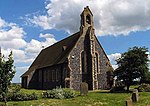Ford Palace
Ford Palace was a residence of the Archbishops of Canterbury at Ford, about 6.6 miles (10.6 km) north-east of Canterbury and 2.6 miles (4.2 km) south-east of Herne Bay, in the parish of Hoath in the county of Kent in south-eastern England. The earliest structural evidence for the palace dates it to about 1300, and the earliest written references to it date to the 14th century. However, its site may have been in use for similar purposes since the Anglo-Saxon period, and it may have been the earliest such residence outside Canterbury. Archbishop John Morton (1486–1500) rebuilt the palace, adding a five-storey tower of brick, and Thomas Cranmer was visited there by King Henry VIII in 1544. In 1573 Archbishop Matthew Parker proposed to demolish it, but it survived to be surveyed in 1647 by commissioners acting on the instructions of the Long Parliament, which had acquired it from the Church of England. The survey found the palace to be in fair condition, but it was largely demolished and the materials sold by order of Parliament in 1658, while the see of Canterbury was vacant. Its site was returned to the Church after the Restoration. In 1661, what remained of it was described as so ruined that its chapel was in use as a barn.
Excerpt from the Wikipedia article Ford Palace (License: CC BY-SA 3.0, Authors).Ford Palace
Ford Hill, Canterbury
Geographical coordinates (GPS) Address Nearby Places Show on map
Geographical coordinates (GPS)
| Latitude | Longitude |
|---|---|
| N 51.3478 ° | E 1.1671 ° |
Address
Ford Hill
Ford Hill
CT3 4LT Canterbury
England, United Kingdom
Open on Google Maps








